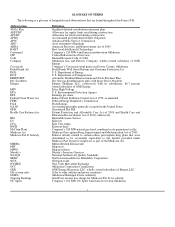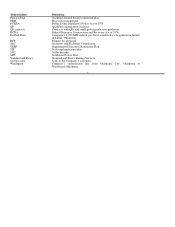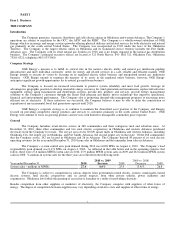OG&E 2010 Annual Report Download - page 15
Download and view the complete annual report
Please find page 15 of the 2010 OG&E annual report below. You can navigate through the pages in the report by either clicking on the pages listed below, or by using the keyword search tool below to find specific information within the annual report.
See Note 13 of Notes to Financial Statements for further discussion of these matters, as well as a discussion of additional
regulatory matters, including, among other things, review of the Company’s fuel adjustment clause.
Regulatory Assets and Liabilities
The Company, as a regulated utility, is subject to accounting principles for certain types of rate-regulated activities, which
provide that certain actual or anticipated costs that would otherwise be charged to expense can be deferred as regulatory assets, based
on the expected recovery from customers in future rates. Likewise, certain actual or anticipated credits that would otherwise reduce
expense can be deferred as regulatory liabilities, based on the expected flowback to customers in future rates. Management’s expected
recovery of deferred costs and flowback of deferred credits generally results from specific decisions by regulators granting such
ratemaking treatment.
The Company records certain actual or anticipated costs and obligations as regulatory assets or liabilities if it is probable,
based on regulatory orders or other available evidence, that the cost or obligation will be included in amounts allowable for recovery
or refund in future rates.
At December 31, 2010 and 2009, the Company had regulatory assets of $495.3 million and $451.4 million, respectively, and
regulatory liabilities of $243.9 million and $363.0 million, respectively. See Note 1 of Notes to Financial Statements for a further
discussion.
Management continuously monitors the future recoverability of regulatory assets. When in management’s judgment future
recovery becomes impaired, the amount of the regulatory asset is adjusted, as appropriate. If the Company were required to
discontinue the application of accounting principles for certain types of rate-regulated activities for some or all of its operations, it
could result in writing off the related regulatory assets; the financial effects of which could be significant.
Rate Structures
Oklahoma
The Company’s standard tariff rates include a cost-of-service component (including an authorized return on capital) plus a
fuel adjustment clause mechanism that allows the Company to pass through to customers variances (either positive or negative) in the
actual cost of fuel as compared to the fuel component in the Company’s most recently approved rate case.
The Company offers several alternate customer programs and rate options. The GFB option for residential and small
general service accounts allows qualifying customers the opportunity to purchase their electricity needs at a set price for an entire
year. Budget-minded customers that desire a fixed monthly bill may benefit from the GFB option. A second tariff rate option provides
a “renewable energy” resource to the Company’s Oklahoma retail customers. This renewable energy resource is a Renewable Energy
Credit purchase program and is available as a voluntary option to all of the Company’s Oklahoma retail customers. The Company’s
ownership and access to wind resources makes the renewable option a possible choice in meeting the renewable energy needs of our
conservation-minded customers. Another program being offered to the Company’s commercial and industrial customers is a
voluntary load curtailment program called Load Reduction. This program provides customers with the opportunity to curtail usage on
a voluntary basis when the Company’s system conditions merit curtailment action. Customers that curtail their usage will receive
payment for their curtailment response. This voluntary curtailment program seeks customers that can curtail on most curtailment
event days, but may not be able to curtail every time that a curtailment event is required. The Company also offers certain qualifying
customers a “day-ahead price” rate option which allows participating customers to adjust their electricity consumption based on a
price signal received from the Company. The day-ahead price is based on the Company’s projected next day hourly operating costs.
The Company also has two rate classes, Public Schools-Demand and Public Schools Non-Demand, that will provide the
Company with flexibility to provide targeted programs for load management to public schools and their unique usage patterns. The
Company also created service level fuel differentiation that allows customers to pay fuel costs that better reflect operational energy
losses related to a specific service level. Lastly, the Company implemented a military base rider that demonstrates Oklahoma’s
continued commitment to our military partners.
The previously discussed rate options, coupled with the Company’s other rate choices, provide many tariff options for the
Company’s Oklahoma retail customers. The revenue impacts associated with these options are not determinable in future years
because customers may choose to remain on existing rate options instead of volunteering for the alternative rate option choices.
Revenue variations may occur in the future based upon changes in customers’ usage characteristics if they choose alternative rate
options. The Company’s rate choices, reduction in cogeneration rates, acquisition of additional generation resources and overall low
costs of production and deliverability are expected to provide valuable benefits for the Company’s customers for many years to come.
8
























